Guest Post by Marla Erickson Boyd
It was one of the rainiest Februaries on record in the Sacramento Valley, and residents of the small semi-rural community of Rio Linda were bracing for the arrival of yet another “atmospheric river.” On the neighborhood social network Nextdoor, residents posted images of recent storm damage and urged one another to stay safe, as local agencies issued wind advisories and flood warnings. In the midst of these pressing human concerns, it would have been easy to scroll past a post from a homeowner who had found an injured bird.
“Anyone missing a white bird? Must have flown in my garage. Seems injured (missing feathers), but it’s eating and drinking.”
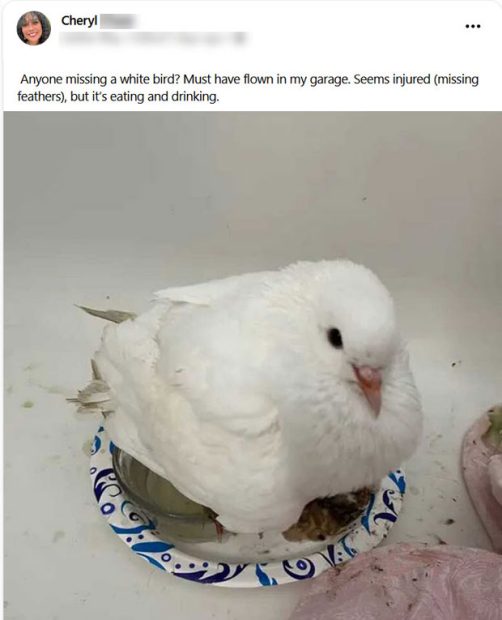
A compassionate homeowner found Clementine injured in her garage
How the tiny, domestic white pigeon found refuge in a suburban garage is both a mystery and a testament to her tenacious spirit. She could not have flown in, disabled as she was by her injuries. Her soiled and drooping right wing was fractured, with broken bone jutting from beneath torn flesh, and a life-threatening infection already setting in. Most of her tail had been ripped out, most likely by a hungry bird of prey whose grip she had somehow managed to escape. She was emaciated, her breastbone sharp as a knife, the result of struggling to survive outside for days without food. Now grounded and vulnerable, starving, in pain, alone, and growing weaker, she knew she had to find shelter from the rain and wind, and a place to hide from predators. When she saw the open garage door and walked inside, dragging her broken wing, she was attempting to “self-rescue” by asking for help from humans. She is alive today because humans did not fail her.
The homeowner who found her, a kind woman named Cheryl with a big heart for animals, knew that this was a domestic bird, and hoped that by posting on social media she would find out who the bird belonged to. If no one came forward, she was planning to contact a local wildlife center or shelter. What she did not know was that many wildlife centers will not take rescued pigeons because they are non-native and domestic, while many shelters and rescues won’t accept them because they don’t see them as adoptable pets. Palomacy is working hard to change this perception through outreach and education that aims to show what wonderful, intelligent, human-social pets pigeons can be.
Soon after Cheryl’s post appeared on Nextdoor, someone familiar with Palomacy replied, and directed her to the one organization that would say Yes to saving this bird’s life. A short while later, Cheryl was able to add a heartwarming update to her original post: “This sweetie is off the get some help via a Palomacy Help Group member for treatment and foster.”
Clementine was picked up from Cheryl’s home and placed in a carrier lined with soft, warm blankets. She was offered a dish of pigeon seed, which she immediately began devouring with a gusto that made it clear she wanted to live! The first stop in her journey to recovery was a visit to Palomacy Care Director Jill, who assessed her injuries, gently cleaned her wound, and administered an initial dose of antibiotics. From there, she was transported 75 miles to the Medical Center for Birds, a world-class avian hospital located in the Bay Area town of Oakley, where she spent the night after receiving emergency care and pain medication to keep her comfortable.
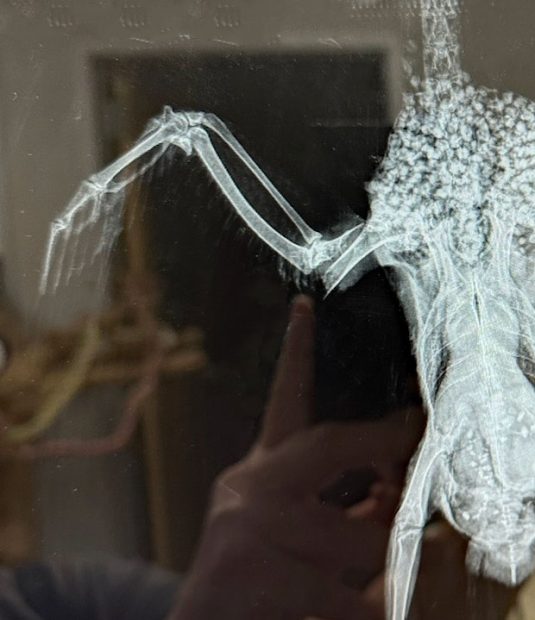
X-ray of clementine’s badly fractured wing
The next morning, the veterinary dream team of Dr. Crystal Schoellmann and Dr. Brian Speer performed the complex surgery that would save her life. Her broken, infected wing was amputated, with the skilled surgeons preserving as much muscle and tissue as possible. She would never fly again, but she would have the opportunity to live her best life in a home where her special needs would be met and she would be safe, cherished, and cared for.
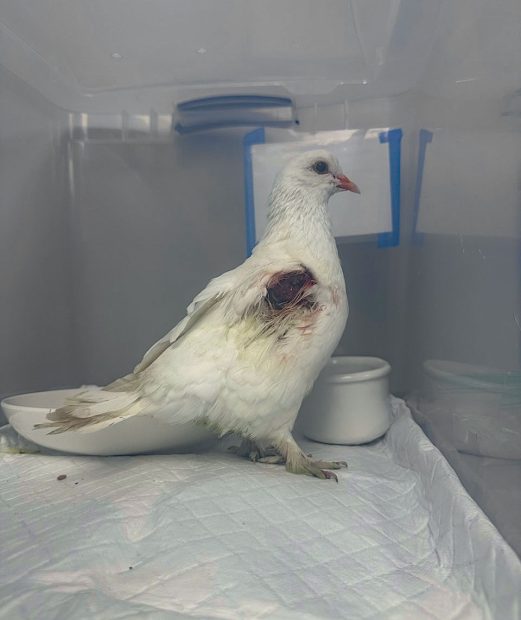
Awake after surgery
Clementine is now settling in with her foster-to-adopt family, and is receiving an abundance of love, cuddles, and treats as she continues to heal from her ordeal. She will always be a petite bird; at her most emaciated, she weighed just 200 grams, but she should reach a healthy weight of around 300 grams with time and proper nutrition. Clementine is swiftly adapting to life as a pampered house pigeon. She has claimed ownership of her space, an extra-large dog crate equipped with ramps and cozy resting places, and guards it with wing slaps and assertive pecks that never hurt, but send a very clear message!
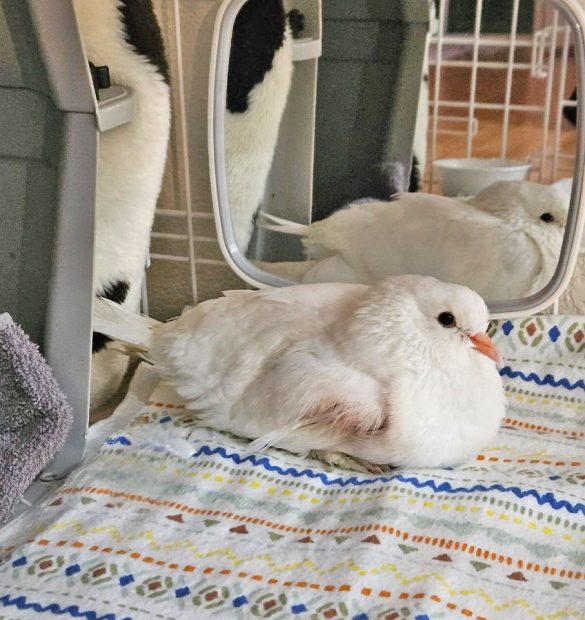
Convalescing in her crate with a heating pad for comfort
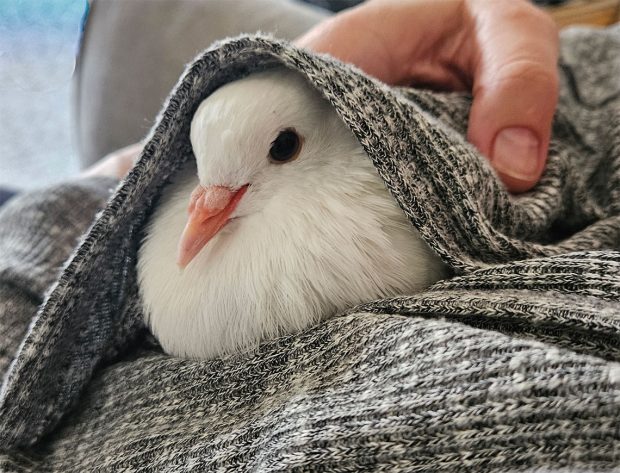
Healing with love therapy
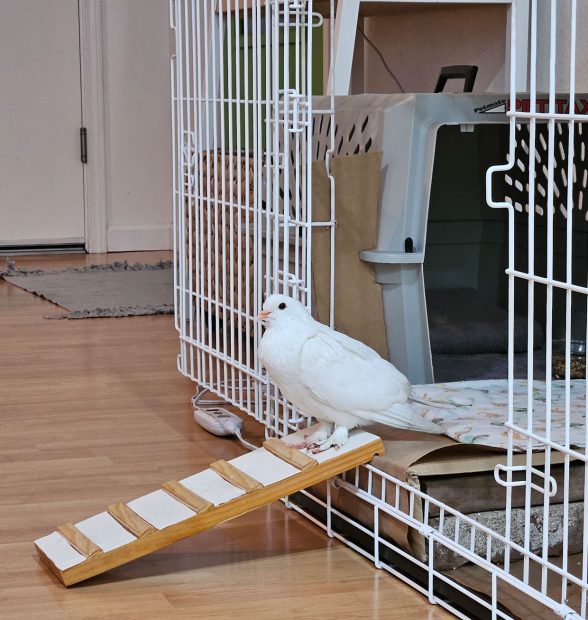
Learning to use ramps
Ramps were a challenge for Clementine at first, but within a few days she learned how to use them, and can now leave her crate whenever she wishes during the day. She can often be found in a quiet corner, loafing contentedly on a low platform made from stacked shoeboxes, which she accesses using steps that were quickly assembled from scraps of 2×4 lumber. Her preference is to get off the ground, but because she lost most of her tail feathers as well as one wing, her balance is poor, and she isn’t allowed to climb too high for now. As she becomes more sure-footed, longer ramps and higher platforms will be built for her, including a windowsill ledge from which she will be able to supervise the backyard and keep an eye on the rowdy flock of wild mourning doves who come there to feed.
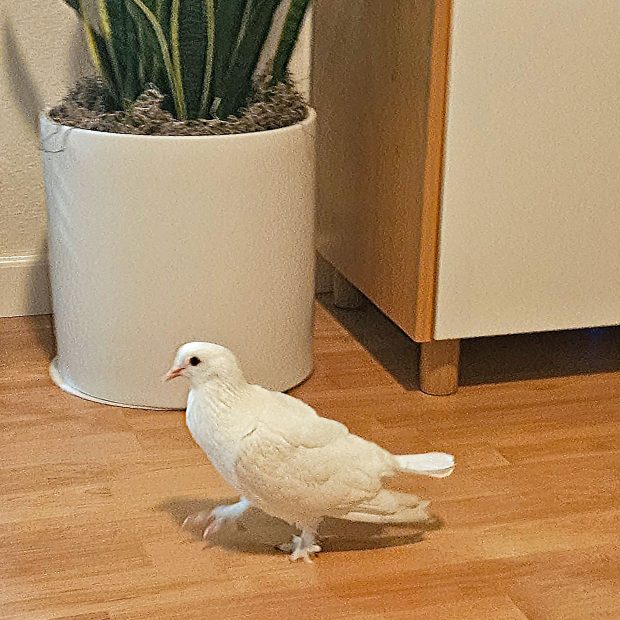
Prancing from room to room on her fancy feathered feet
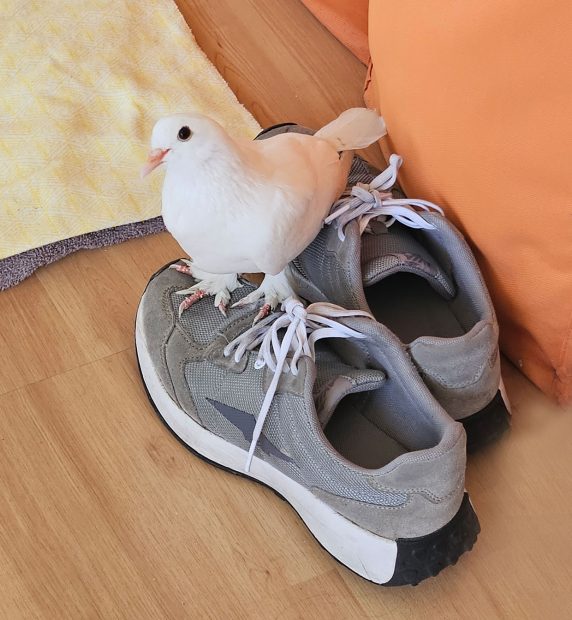
Clementine enjoys conquering shoes
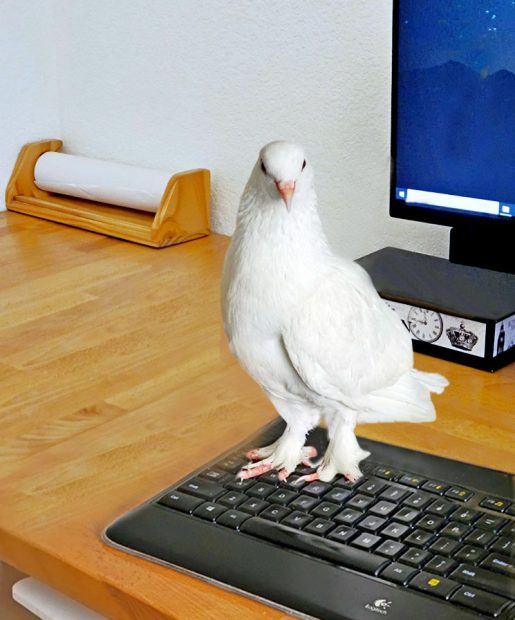
Clementine in the office (micro manager)
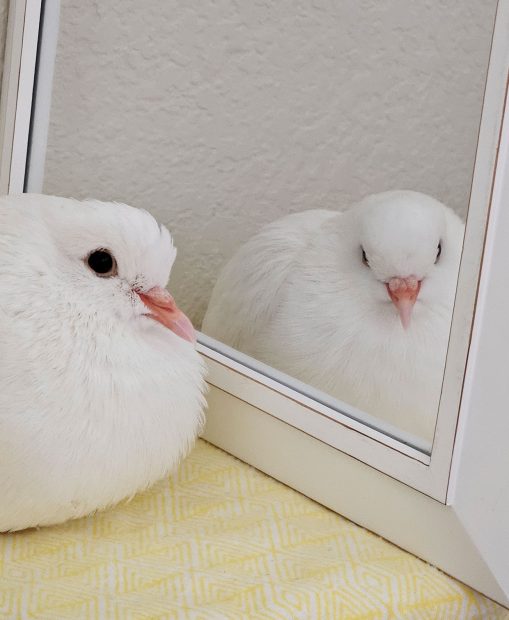
Peacefully gazing at her reflection in the mirror
Clementine loves mirrors, and finds joy in peacefully gazing at her reflection. She also loves to be active, prancing from room to room on her fancy feathered feet, foraging for stray seeds and crumbs. She is growing more confident by the day, but if something spooks her – a loud noise, or a sudden movement – she sprints across the floor, races up her ramp, and ducks into her crate where she feels safe. Then, a minute later, when she is satisfied that the danger has passed, she pops back out and strolls around casually, pausing to preen herself with deliberate nonchalance, as if to say “you never saw that!”
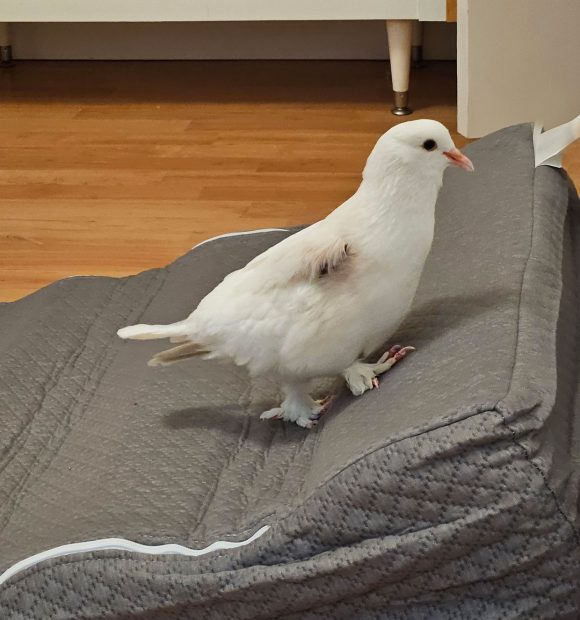
A wedge pillow makes a good ramp
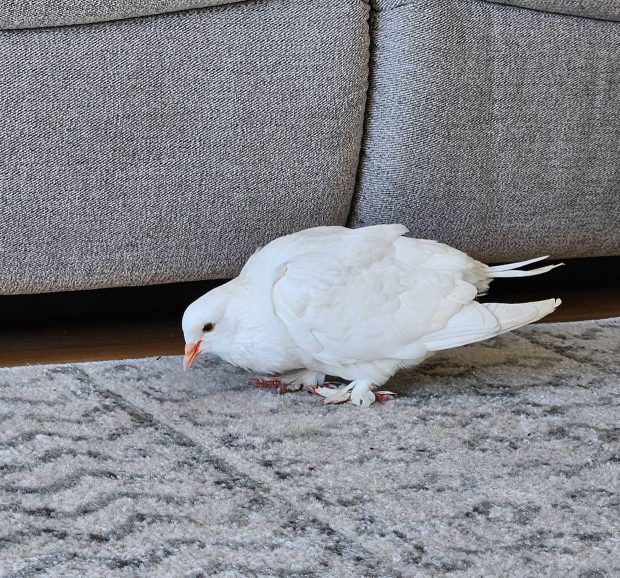
Clementine loves to forage for stray seeds in the rug
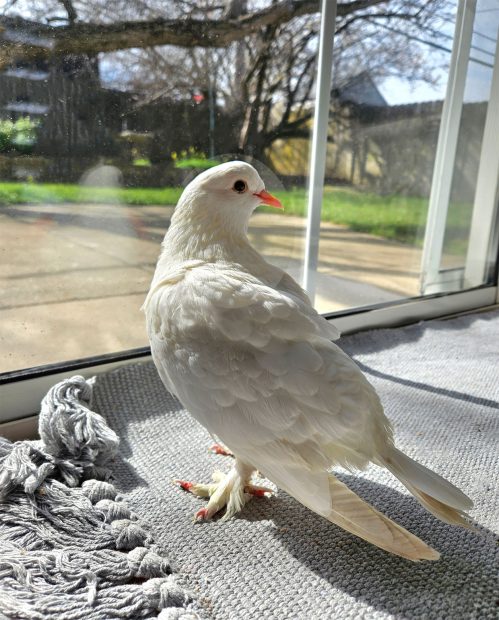
Safe inside, Clementine enjoys looking out
It was inevitable that the people caring for this brave and feisty little girl would fall head over heels in love with her. They look forward to giving her a forever home, and as soon as she is ready, they plan to adopt a compatible mate for her to snuggle, build nests, and sit on (fake) eggs with.
Unlike the miner’s daughter in the familiar American folk song, this Clementine is not “lost and gone forever,” because Palomacy was there for her with its incredible network of Help Group members, volunteers, fosters, adopters, and donors. Your support makes it possible for Palomacy to provide life-saving care for birds like Clementine, and so many more, who deserve the chance to live safe, happy lives in non-breeding, non-exploitative forever homes. Thank you for helping Palomacy to help them.
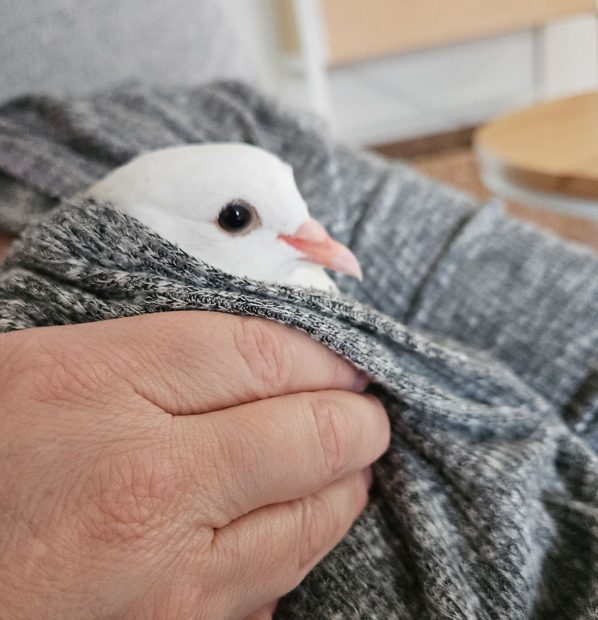
Safe and loved
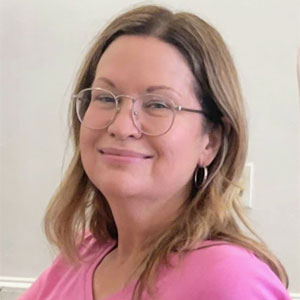
Marla became a pigeon person in the spring of 2023, when a tiny Birmingham Roller hen named Penelope showed up in her backyard, asking for help. The Palomacy website and online Help Group provided all the advice and support she needed to care for her new pigeon companion. Later, when Penelope fell ill with what turned out to be proventricular cancer, Marla turned to Palomacy for advice and hands-on lessons in gavage feeding, medicating, and comforting her beloved friend in her final days. In the process of loving and losing Penelope, Marla developed a deep appreciation for these clever, sweet, loyal birds who are so misunderstood, abused, and exploited for human profit and entertainment. These days, she carries a bag of seed, a bottle of water, and a rescue kit in her car, always on the lookout for pigeons in trouble.
Please donate to help Palomacy help birds

